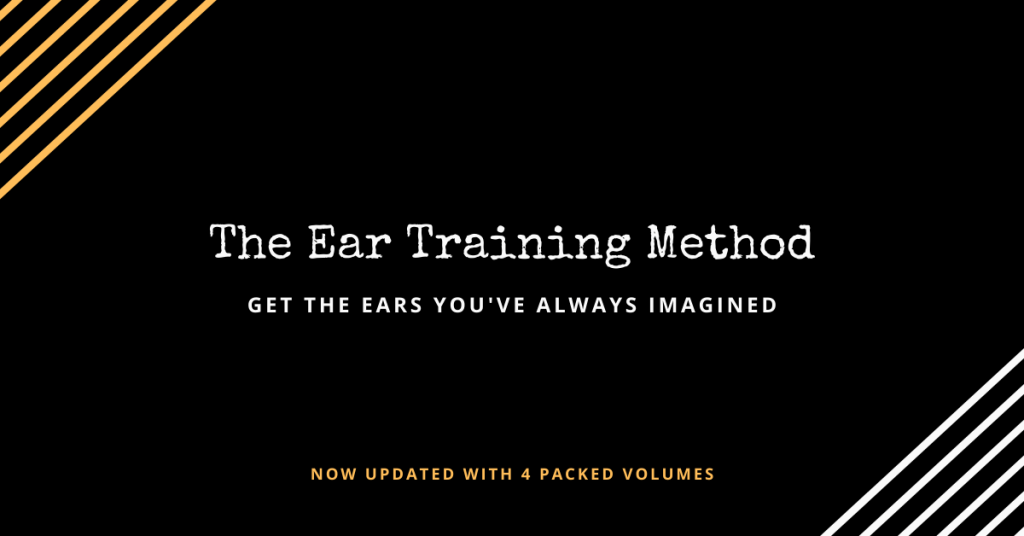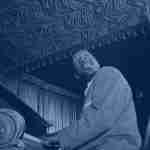Jazz ear training – What makes it different from general ear training? That’s a great question and when a reader recently asked this, it definitely made me think. They both focus on intervals, chords, root movement, and have other common ground, but how are they actually different?
Over the years, I’ve taken quite a few general ear training classes and had both positive and negative experiences. I will say though, no formal ear training class gave me the necessary ear training tools and techniques to develop as an improviser.
And really, it’s not their fault…
First off, the specific aspects of jazz ear training that make it different from general ear training are rarely talked about, or even thought about, so most ear training classes typically go about teaching ear training in a general way.
And secondly, ear training isn’t really meant for the classroom…
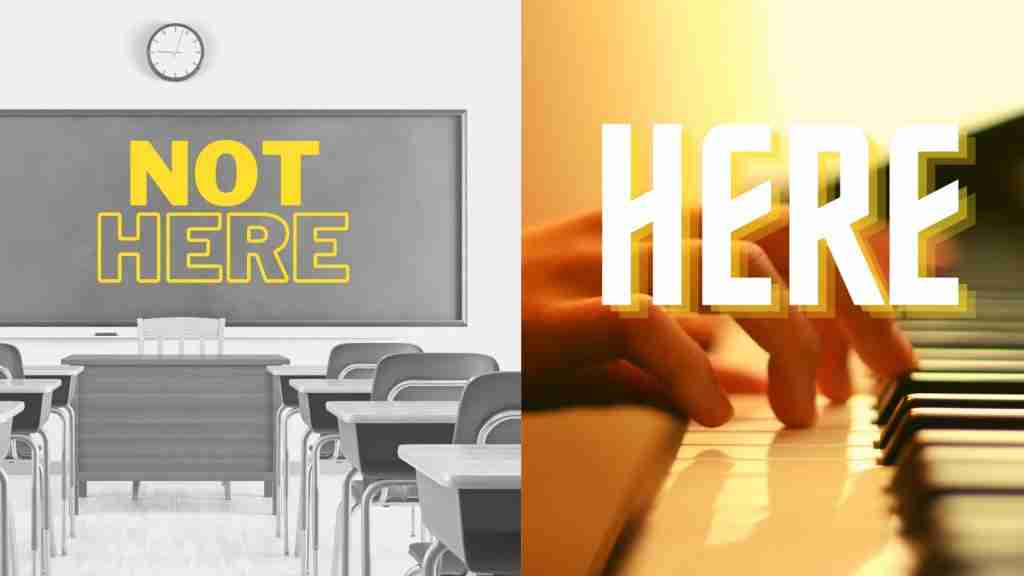
You see, ear training is something you do every single day on your own – a daily practice, pushing your ear forward, building upon your current aural knowledge while continually strengthening your fundamentals.
Ear training is not difficult or magical. It’s simple and repetitive.
You continually study the sounds you want to get familiar with and ingrain them on a deeper and deeper level until they click.
Okay, so let’s get into what makes ear training in jazz a bit different…
A deeper level of ear training
The very first difference has to do with the mindset…
In many general ear training choruses, the ear training mindset is treated much like guesswork – you listen to a sound and take your best guess as to what it is, and if you get the correct answer, then you’re the big winner and you move on.

But here’s the thing…
Nothing in ear training should be guesswork.
You shouldn’t have to think…hmmmm It sounds like a major third, but it might be a minor third. Um, let me guess…a major third?
Your goal is to automatically know without thinking that it’s a major third, and in jazz, this is a requirement because knowing this aural knowledge is how you play, how you practice, and how you learn.
So the very first thing to understand about ear training specifically for jazz, is that you have to get the sounds you’re studying to a much deeper level than you might need to for any other type of music.
Jazz is all about how you hear, so it makes sense that we require a deeper aural knowledge, so now let’s get into the specific requirements for a jazz musician…
The ear training requirements of a jazz musician
A jazz musician has specific ear training requirements because they’re dealing with situations that you simply don’t encounter in other music.
In jazz, we have to…
- Improvise over many chords, not just a single chord vamp
- Understand and use chord voicings, not just root position chords
- Create melodies over chords in real-time
- Learn the melody and chord changes of tunes from recordings
- Deal with chords changing in the moment by the comping instrument
- Be able to hear altered & upper structure chord tones
- Easily transcribe jazz solos and language
- Apply alterations to chords while soloing
- Create background riffs on the spot
And the list goes on…
But as you can see the jazz musician has to get beyond the basics and internalize a wide variety of sounds in order to hear, play, react, and lead in the moment.
And although all of these points are important, you’ll probably use your ear the most to do these 3 crucial activities…
1.) Learn Tunes From Recordings
In jazz, one of the best ways to learn a tune, is to study the recordings of the masters…
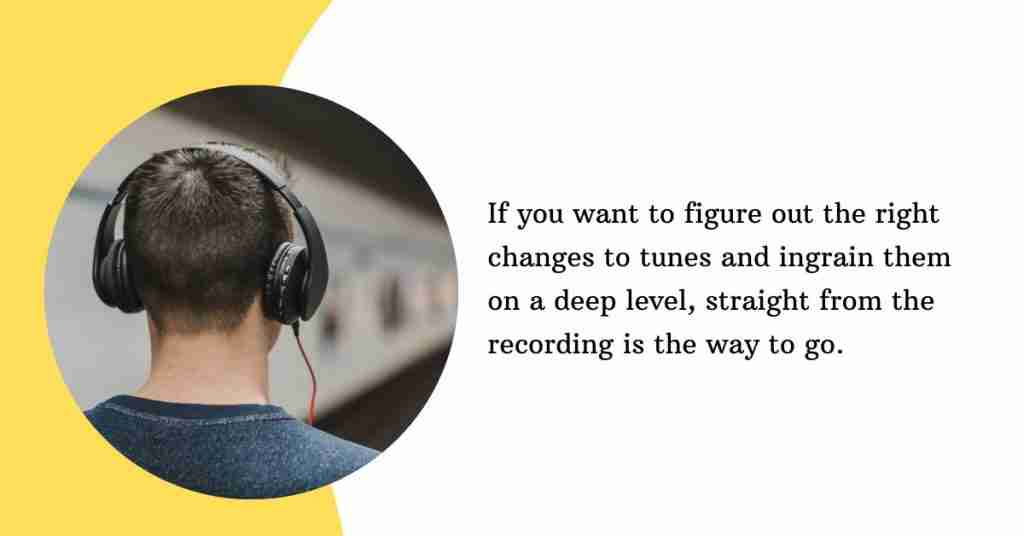
But, learning tunes like this is not easy. The only way to effectively do this is to already have all the structures that you’re going to hear, built up in your mind.
So, jazz ear training must prepare you for this task through the study of intervals, chord tones, voicings, and progressions, in a very particular way.
2.) Transcribe Language & Jazz Solos
A jazz musician learns the jazz language primarily through the process of transcribing.
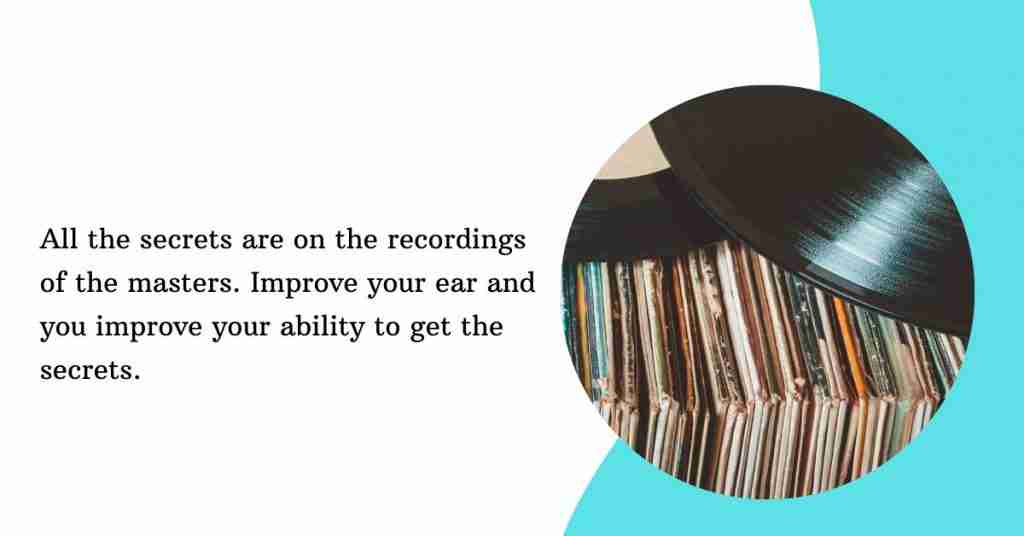
And like learning tunes from records, transcribing language and solos is not so easy, especially if you haven’t done the necessary prep work.
Your daily ear training practice must get you ready to be able to quickly and accurately take jazz vocabulary from your favorite players.
3.) Actually Improvise!!
To obtain a level of freedom when you improvise, you need to have great ears. There’s just no way around it…
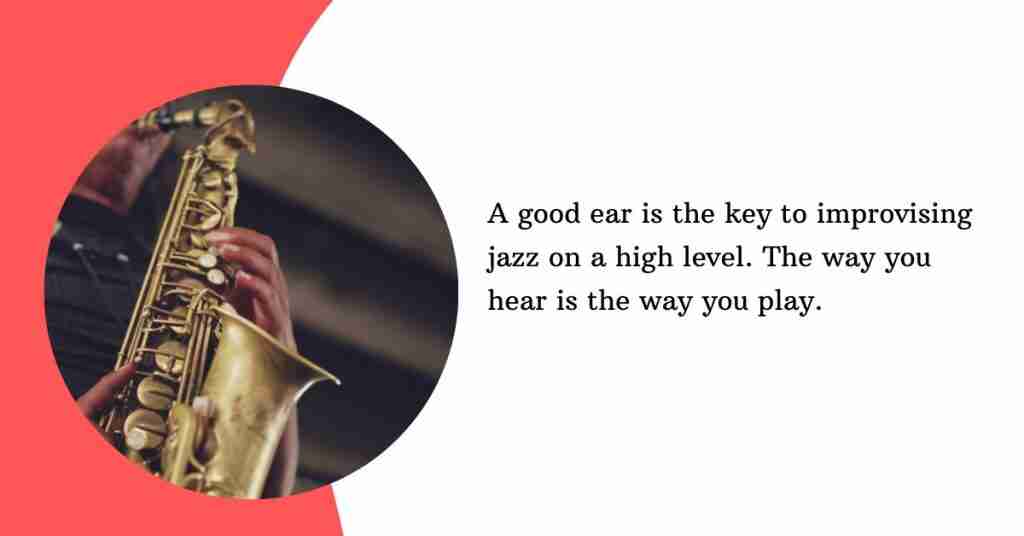
This creative in-the-moment magic of jazz improvisation can only happen when your ear can lead you in the right direction.
So just like learning tunes and transcribing, jazz ear training has to grow your aural awareness into an intuitive tool that you can use during your solo.
But how do you do this?
Well, it all starts with starting to hear the most basic melodic unit in music: the interval.
Master your intervals
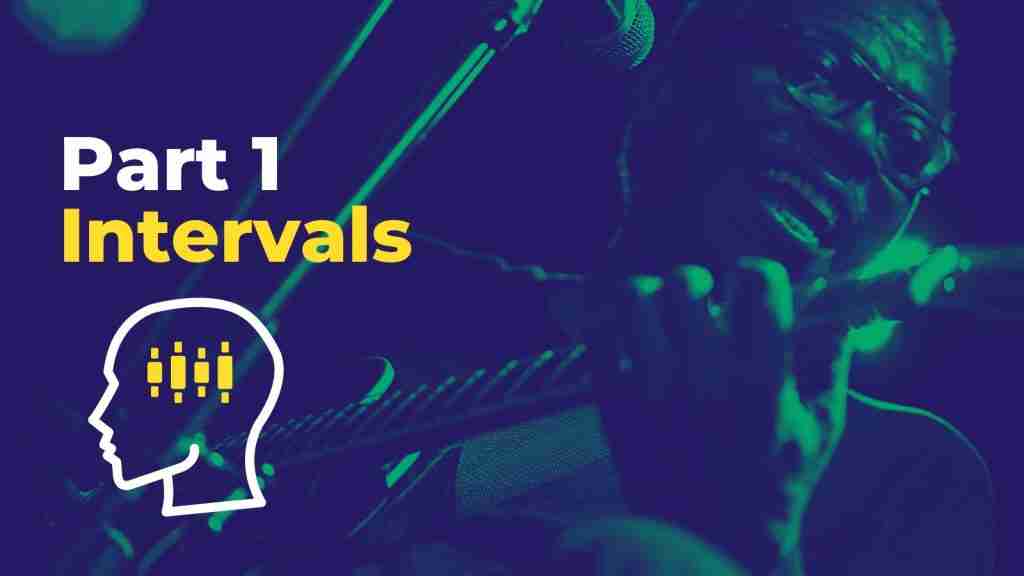
Ok, so I’m sure you’ve done some interval practice before, but I want you to be completely honest with yourself…Are they actually mastered?
Intervals
How quickly can you tell me what interval this is?
Or how about this one…
Did you have to think for a moment or listen to it several times before you could answer? What about if I played multiple intervals in a row, how easy would that be for you?
If this little quiz was tricky (I’ll give you the answers in a moment) don’t worry…getting aural information to a point of instantaneous recall takes time.
And I’m going to share a little secret with you…
I’ve worked on my intervals for years and they could still be better!
Why? Because no matter how good you get at this stuff, it can be better. You can always work toward hearing something in less time and hearing it more clearly. There’s no end or destination to reach, you just keep getting better.
Intervals (Answers)
So how’d you do? Here are the answers…
- The first interval I played was a tritone up
- Then I played a Major 7th down
- And finally a Major 3rd down, then a minor 6th up, and a Major 2nd up
You can begin to master your intervals in 28 days if you work hard at it, but remember, we’re not looking for mere identification. We want to own the material.
We want our intervals to be so good, that we’re able to hear a bass line and know exactly what the intervals are, or hear a phrase in a solo and pick out each of the intervals.
If your intervals aren’t at a place of mastery, then you won’t be able to apply the information and actually make use of it.
chord tone colors
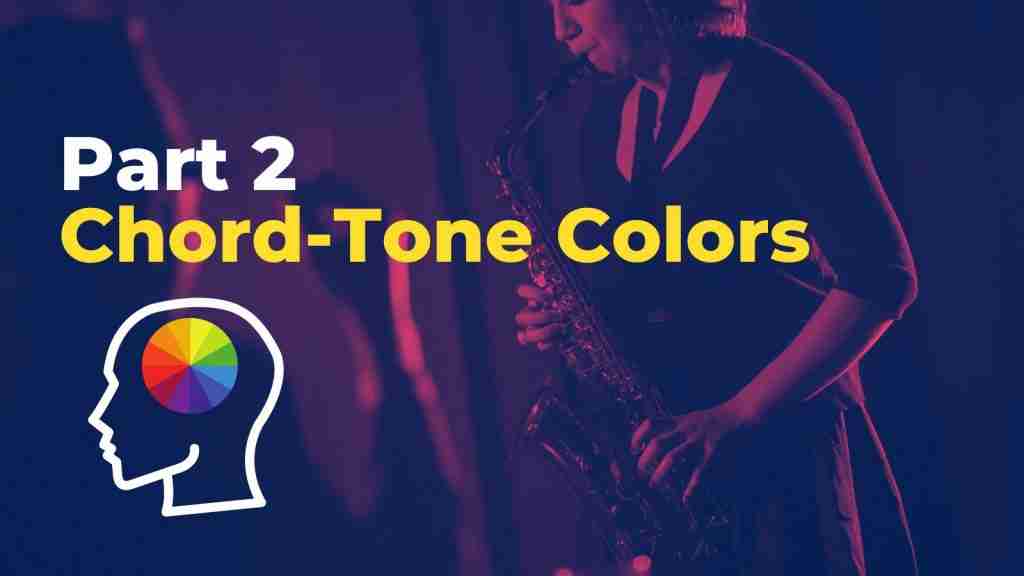
This next part of jazz ear training is something that really sets it apart…
Most general ear training focuses on identification of intervals, triads, and seventh chords. But, the idea of how a specific chord tone sounds on top of a chord is usually not studied that much.
In all forms of music, this chord tone color concept is very important because the way a specific chord tone sounds in a particular context is a huge part of what makes a strong melodic statement sound the way it does.
You see, each chord-tone has a color, or a mood, that you can hear in context, for example the major 3rd on a major chord sounds a certain way.
Or, a b9 on a dominant chord…it has a different sonority…
Developing a sense for this chord tone color gives the improvisor a huge leg up when they’re listening to or studying music, and want to quickly decipher what it is they’re hearing.
Chord-Tone Colors
How are your skills in this department? Can you hear what each chord tone sounds like? What chord tone am I playing here over a dominant chord?
And what about here?
And one more chord-tone color on a dominant chord for you…
Chances are this might be a little beyond where your current hearing ability is…
But just like intervals, all it takes is the right ear training method and some dedication. You can learn to hear each chord-tone color, and not just the basic 1-3-5-7 of a chord, but all the chord-tones.
You see, as jazz improvisers we must go even further when it comes to hearing chord tones…
Not only do we need to learn to hear the basic chord tones, but we need to acquire an aural concept for the upper structure chord tones 9, 11, 13, as well as the many alterations that can happen, like b9 or #9 on a dominant chord.
And with this necessary skill, instead of hunting around for a note on your instrument, you’ll know exactly what each note sounds like in the context of a chord.
Chord-Tone Colors (Answers)
Okay, so to give you the answers…
- First I played a G7 chord with an Eb on top, the b13th
- Then I played a Bb7 chord with an E natural on top, the #11
- And finally I played a C7 chord with a D on top, the 9th.
These unique sounds are rarely given the attention needed to master them, but if you want to truly understand what’s possible and what you’re hearing on the recordings of your heroes, these sounds have to be internalized.
Hearing chord voicings
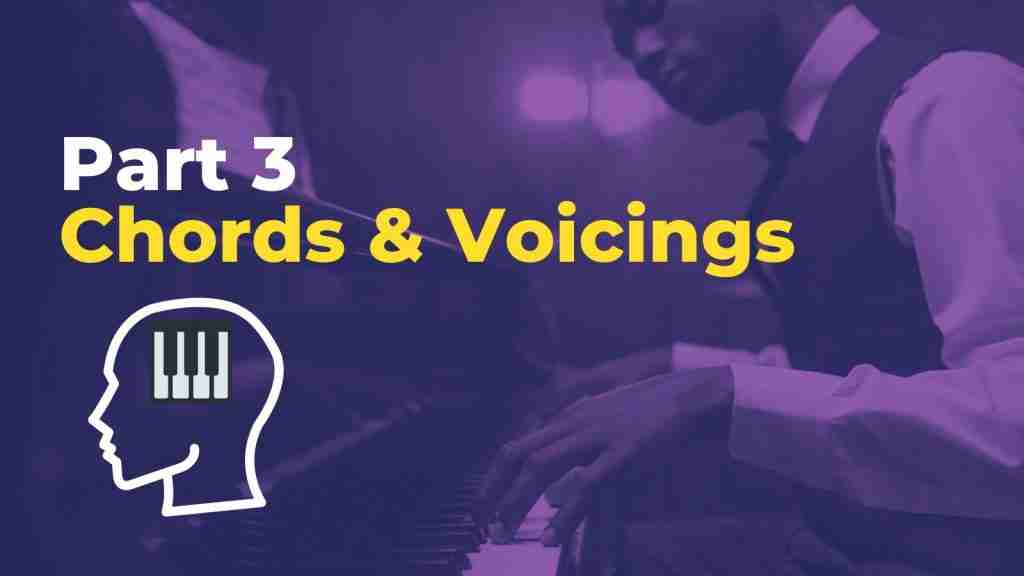
Another unique-to-jazz ear training concept is Chord Voicings…
So what is a chord voicing?
Rather than playing a chord in root position (1-3-5-7), the comping instrument, like piano or guitar, will “voice” a particular chord, which means they choose:
- Which chord-tones and harmonic tensions to play
- What order they want to play these notes in
And what makes this tricky, is they can choose chord-tones from the entire chord structure up to the 13th (check out our jazz theory course for lessons on this) and they can modify their choices in real-time.
Listen to Brad Mehldau’s chord voicings on Prelude to a Kiss.
See how a pianist’s unique voicing decisions can express great beauty? He’s not playing root position chords, but instead voicing each chord how he sees fit.
Hearing a chord voicing is tricky, but let’s give you a shot…
Chords & Voicings
First, just try to tell me what type of chord I’m playing and then, if you think you can clearly hear what kind of chord it is, try to figure out the specific chord voicing that I’m playing.
Okay, here’s your first chord…
Can you hear it? Let’s go to the next one…and try to tell me everything that’s included in the chord…
And let’s do one more…
To understand piano chord voicings, first study this lesson on Piano Basics: Necessary Skills for the Non-Pianist
This lesson will teach you how to play basic chord voicings and how to understand what they are. And then, to begin to hear chord voicings, put a tune in Transcribe and take it one chord at a time.
- First listen for the bass note and then listen to the piano player
- What kind of 3rd does the chord have? Is it major or minor?
- What kind of 7th?
- What other notes are in the voicing?
- What order are the notes in?
If you take it slow, loop the chord in Transcribe, and ask yourself these simple questions, you will be able to pick apart any voicing you hear.
Learning to hear chord voicings is absolutely essential. Without learning to hear chord voicings, you’ll still be in the dark to what’s going on around you while you improvise.
Chords & Voicings (Answers)
Alright, here are the answers from this section:
- I first played a root position A Half Diminished chord. I put the root in the bass (A), and I’m playing 3-5-7 (C-Eb-G) on top
- Next I played an F#7b9 nat13 chord. F# is in the bass, with 7-b9-3-13 (E-G-A#-D#) on top
- And finally I played a C Maj7b5 chord. C is in the bass with 3-b5-7 (E-Gb-B) on top
So how’d you do? Could you tell me what type of chord I was playing? Could you figure out the exact chord voicing?
Figuring out chord voicings by ear is not an easy skill to develop, but with the right ear training process, it is very possible to attain.
And as you can see by today’s lesson, jazz ear training is quite a bit more involved than general ear training, so it requires a different method…
The Ear Training Method
When you’re training your ear as a jazz musician, you’ve got to get beyond the general idea of ear training and work on practical knowledge that you can apply in the real situations that you’re going to find yourself in time and time again.
You want to be able to…
- Clearly hear bass lines
- Pick out melody notes on top of chords
- Instantly know chord qualities
- Hear chord voicings of major, minor, dominant and more
- Hear any chord tone including upper structure and altered chord tones
- Transcribe tunes by ear
- Hear chord changes and progressions easily
Obviously there’s a ton to know, but with the right method and process at your disposal, you can turn these goals into a reality.
This is why we developed an ear training method that’s tailored specifically for the jazz musician – a method that has meticulously organized & automated the aural knowledge you need to know as a jazz improvisor or ANY musician aspiring to a higher level of musicianship.
The Ear Training Method is the fastest and easiest way to improve your ear.
You’ll learn everything we covered today and a whole lot more! It’s PACKED!!!
- Intervals, Triads, Seventh Chords
- Chords With Upper Structures
- Chord-Tone Colors
- Chord Voicings
- Chord Progressions
If you want to improvise and play music in a way where you’re actually hearing what’s going on around you, then you have to continually study the sounds that you’re going to be interacting with.
You have to develop a relationship with intervals, triads, seventh chords, chord voicings, chord tones, upper structure chord tones, altered chord tones, progressions…and this relationship must be deeper than you ever imagined.
Get on track with a solid Jazz Ear Training Method and get the ears you’ve always imagined!


